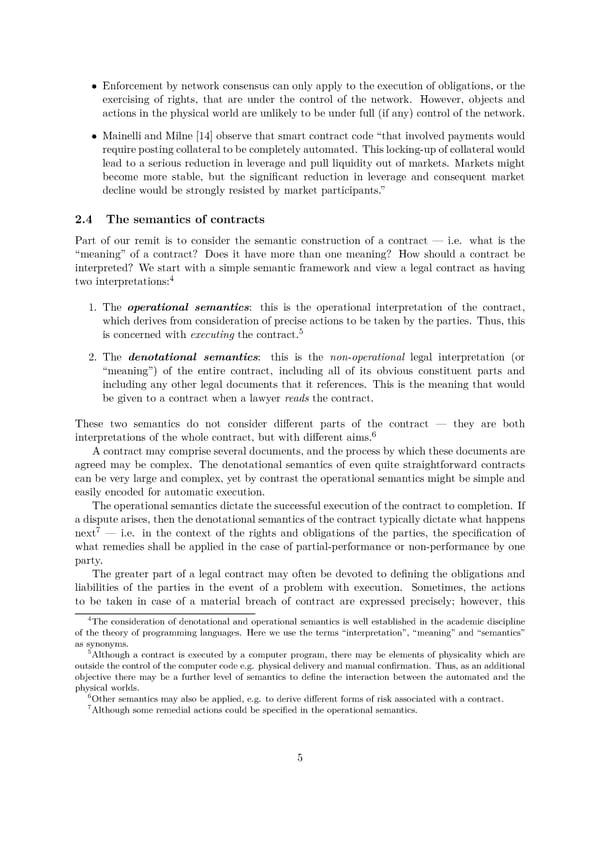• Enforcement by network consensus can only apply to the execution of obligations, or the exercising of rights, that are under the control of the network. However, objects and actions in the physical world are unlikely to be under full (if any) control of the network. • Mainelli and Milne [14] observe that smart contract code “that involved payments would require posting collateral to be completely automated. This locking-up of collateral would lead to a serious reduction in leverage and pull liquidity out of markets. Markets might become more stable, but the significant reduction in leverage and consequent market decline would be strongly resisted by market participants.” 2.4 The semantics of contracts Part of our remit is to consider the semantic construction of a contract — i.e. what is the “meaning” of a contract? Does it have more than one meaning? How should a contract be interpreted? We start with a simple semantic framework and view a legal contract as having two interpretations:4 1. The operational semantics: this is the operational interpretation of the contract, which derives from consideration of precise actions to be taken by the parties. Thus, this is concerned with executing the contract.5 2. The denotational semantics: this is the non-operational legal interpretation (or “meaning”) of the entire contract, including all of its obvious constituent parts and including any other legal documents that it references. This is the meaning that would be given to a contract when a lawyer reads the contract. These two semantics do not consider different parts of the contract — they are both interpretations of the whole contract, but with different aims.6 Acontract may comprise several documents, and the process by which these documents are agreed may be complex. The denotational semantics of even quite straightforward contracts can be very large and complex, yet by contrast the operational semantics might be simple and easily encoded for automatic execution. Theoperational semantics dictate the successful execution of the contract to completion. If a dispute arises, then the denotational semantics of the contract typically dictate what happens next7 — i.e. in the context of the rights and obligations of the parties, the specification of what remedies shall be applied in the case of partial-performance or non-performance by one party. The greater part of a legal contract may often be devoted to defining the obligations and liabilities of the parties in the event of a problem with execution. Sometimes, the actions to be taken in case of a material breach of contract are expressed precisely; however, this 4The consideration of denotational and operational semantics is well established in the academic discipline of the theory of programming languages. Here we use the terms “interpretation”, “meaning” and “semantics” as synonyms. 5Although a contract is executed by a computer program, there may be elements of physicality which are outside the control of the computer code e.g. physical delivery and manual confirmation. Thus, as an additional objective there may be a further level of semantics to define the interaction between the automated and the physical worlds. 6Other semantics may also be applied, e.g. to derive different forms of risk associated with a contract. 7Although some remedial actions could be specified in the operational semantics. 5
 Position Paper | Smart Contract Templates Page 6 Page 8
Position Paper | Smart Contract Templates Page 6 Page 8